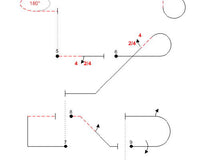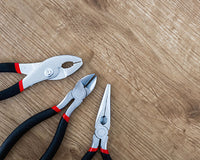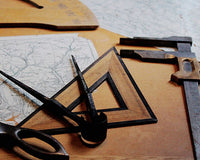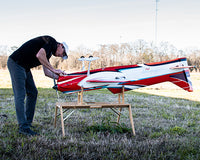This article is written by CK Aero Founder Bryan Hebert
This is the foundation of the problems with performance of the model versus the performance of the modeler trying to fly it.
The Beginning of Rudder Knowledge
With the art of trimming, there is one basic difference that affects your results when it comes to a good flying model: The difference between the model’s ability to fly well and the ability of the modeler to make it fly well.
The quality of the design can be affected by how well it’s set up. The ability of the design is often blamed when it could be the inability of the modeler to set it up correctly. This is why I make flying videos of the things that have been deemed “impossible” by the experts just to prove some of these things are possible. When the Contra unit came out, I knew the problem associated with the Contra’s yaw issues and that my designs would not be affected by the so-called aero issues that it produced (a lot of other airplanes could fall in this category if set up correctly). I`ve been proven correct, again, but and all I hear are crickets now. The same can be said about positive wing incidence, down thrust, and stab placement. I`ve been proven right time after time….but I digress.
How did I figure it out? How could I know this? Why am I so confident? Most aerodynamic thought and conclusions are owned by the professional engineers and aerodynamic gurus. This knowledge and terminology gets handed down to the rest of us dreamers. We like to use big words and subscribe to the cause and effects that have been tested and concluded in the full scale world. With the model airplanes, our conclusions are usually a result of lazy thinking and feel good answers. We slap it around on the forums for a while and conclude that it`s not possible or an expert comes on and shows a calculation from an engineering manual with no actual knowledge of the problem on a model. Testing and common sense has left the modeling world, it seems. What used to drive model improvement from the garage tinkerer has been left behind to the past (we are only equipment installers now days). That sense of wonder we had as a young child where we thought anything was possible has left us for the convenience of an A.R.F..
When I make a claim on model performance or try to correct the record that goes against common belief, I hit a brick wall of skepticism because, as we know, I`m not the best writer and I get out-maneuvered on paper sometimes. Nevertheless, facts are stubborn things and the majority of standard pattern trimming now is based on my methods. Some have told me, “Your knowledge only comes from testing”. They are right! Testing and conclusions guided by experience, hard work, and honesty. I can duplicate and demonstrate everything I write on paper because I`m confident in the result and I can make sense of what I know through the testing and building I`ve done over the years.
So, why do I say these things? Not to brag, but to inspire others! Don`t follow the forum thought crowd. Prove things for yourself like I have done. If you can’t duplicate what someone claims, find out why, experiment, explore, and improve. In the end, you will have firsthand knowledge no one can take away from you. If you want to design models, don`t be afraid to fail. It`s the best teacher, and don`t be afraid to explore. We have such a big grey area to play with. I have enjoyed proving my modeling hero`s wrong and right on many things. You never really know something until you experience it yourself.
The deeper you dig and explore, the more you will understand. Beware, it can be a long frustrating journey and you may not be competitive for a long time if you follow my path. On the other hand, it will improve your entire game. A great scientist once said, “If you can`t explain a problem simply, you don’t understand it yourself.” This basic trim understanding is why I`m able to trim airplanes I have not designed. I can even do it over email or over the phone. My knowledge came from personal experience and success, not mass thought on a forum.
I always say if the model is not better than you, it`s holding you back! I`m certain this is the case and as you get in the top classes, it`s even more evident. There are so many model choices out today from many sources. Some are models designed by top tier competitors and some by good promoters. Some claim to fly just like a pattern plane! They all have a place in the sport. Your job is to navigate the hype and rah-rah out there and pick a design that you can use that fits your budget and flying level to help advance your performance. The most important tool you can have is learning proper setup that will move you along to the next level. This knowledge will enable you to pick the best design for your needs or abilities.
On this site, we are trying to give you insight into how you can be sure your approach will be consistent and pure. I have developed a trim- setup philosophy based on my own trimming knowledge and design purity. This knowledge is well proven and is being used by many top pilots and team members around the World. This is a good place to start your trim journey and maybe try to prove ME wrong.
The more you know in the setup realm, the better flier you become ,the more important every little detail is. Whether it`s the perfect angle of a control horn or the right servo selection for the surface, everything matters. Sometimes I look at the radio setup of another model and realize just how much I have learned either from my failed setups, improving as a pilot or trial and error. I want to fix every poor set up I see because I know, you cannot get a good result built on a poor foundation. If we don`t take the time to make everything as perfect as we know how, we are wasting our time, especially if we are trying to perfect our results on the judges score sheets. Every setup can be eventually improved and, even if there is a slight improvement, it`s worth it.
Harold Collins and I were asked once when we used to build every Patriot design from scratch, “If you finish the model and realize your wings are off by say 1/64″, what would you do ,is that close enough?”. Our reply, “If it can be measured, we will do whatever we have too to fix it”. You cannot claim perfection if you know something is not as perfect as it can be. You cannot improve anything until you have the confidence that it`s as accurate as you know how to make it at that time. This allows us the opportunity to improve our measuring and setup skills from a simple Robert meter to using digital inclometers.
I have tried every available incidence meter under $100.00 and I can tell you only one or two meet my standards This standard is only as accurate as 1/10th of a degree. Is there room for improvement? Yes, but until I can make the kit parts we are manufacturing more consistent, I cannot say with confidence I would be able to beat that goal. So for now, I`m satisfied. I will look for improved measuring tools to get better accuracy. In the end, the air tells the truth. We need to know how to take that answer and make the correct change according to the trim settings after the flight.
I have had the good fortune to work with some great manufacturers over the years putting designs out. Some have not been so happy to work with me because I expect perfection. They expect to sell airplanes and make a profit. There is always a fair amount of compromise both ways no matter who the company is. I never stop pushing the limits. When I sent the Allure design to Xtreme, they stared at it for hours with no one saying a word. It looked like an impossible task. Those who saw the plug said I was crazy. Now, it`s a new standard and being copied. All of the new monoplanes, since the Allure release, have used it as a standard to compare to. This respect is from the knowledge and experience in building composite designs, and independent, forward thinking.
The same thing happened with the Shinden many years ago. For its day, it was a very large airplane and almost an impossible task. To move forward we, as competitors, designers, and flyers, have to stay pushing the limits be it weight, size, skill, measuring or, like Brenner Sharp has proved, a radical departure in how we think about our propulsion system. As schedules become harder for all classes in pattern and F3A, designs will change rapidly in the future. A lot more Bi-planes and bigger mono planes will push the boundaries even farther. I think the loudest voices for weight increase will eventually come from the manufacturers trying to satisfy designers and customers alike. Their collective voices may eventually move the needle and get the weight rules increased. But, I`m not holding my breath.
Ok I got off topic a little and chased a few rabbits!
Rudder Power, Knife Edge Ability, and Down Thrust
I don`t know if you stay engaged with the F3A Maneuvers and direction of our sport or not but things are getting crazy! I love it! If you watched my knife edge videos here on this site, it may not seem all that important or you may say it`s not that impressive! If you have ever tried to do this on your own airplane, you will see it does seem impossible. These videos are filmed to show that it is possible and not just babbling from a crazy Cajun.
If you’re going to improve a design, you have to know everything about the design you’re improving. This means testing, moving, cutting, changing, adjusting the wing incidence, changing the engine thrust, and moving the C.G. Every change you make forces you to change the rest of the setup so it seems endless. After time you can settle on go-no-go limits for each adjustment. Every design is a little different but, in the end, they are very similar. What separates them is how the model is setup down to the smallest details. When you find the limit on a design, you find out what can be improved if your honest with the assessment. Then, that’s where the work starts all over again. This is why I released my trimming guide. It`s a launching board for your experiments. I take 80% of the guess work out for you and lead you on the right path.
When I claim my design is capable of something, it’s because I have proven it can be done. I get guys who email me and ask me why will their models do this or that? Well, this is why I wrote what I did at the beginning of this article. What the model is capable of and what you’re capable of may be a big difference. That’s where my trimming guides and trimming help articles play a role. These articles are full of information that gets glossed over and just read. Sometimes it’s not appreciated for the content held in the article. The harder the class you fly, the more you have to know about trimming or you will go backwards on your reward with the judges. Every class advancement takes a skill advancement. The smallest improvement to wing incidence or C.G. changes can have a huge effect on your ability to do a maneuver or even an entire pattern correctly.
In my trim guide you will notice I say the more incidence you run in the wings, the farther forward you may have to place the C.G. This is the same for down thrust. The more down thrust you have, the more forward the G/G has to go. With both settings over adjusted, guess where the airplane wants the CG to be. WAY FORWARD to keep the mixes down. This will quickly have diminishing returns. So, how do you know what is the standard for that model? That, by the way, is what the designer should have figured out for you. This is where some of the promoters and designers separate. Set the model up for your level of competition but strive to improve it always. Everybody wants the top design to compete with. Are you able to handle it? Can you take advantage of its abilities or will the perfection of the design actually hold you back? F3A Unlimited has a few entry level models that are really good choices and are hard to beat! The expectations from the modelers are not realistic some times. It`s almost a shame when I look back where pattern started. It’s gone from everybody being able to scratch build from nothing to complaining about a paint seam out of place on an entry level model they could never duplicate themselves. We have grown spoiled!
The only perfect models out there are the ones built by you! When you do it yourself, you would be surprised at what you let slide and overlook. Concentrate on the setup, trim and “flyability” of the design. Improve your setup skills until you can earn the right to expect perfection. In the end, the scores are what matters. If you can improve your flying and scores, it becomes easier to focus on the small things later like paint schemes or whether a wing tube is glued in like you would do it.
I teased with a question early in this article about how did I know about the contra yaw problem and how to fix it. Testing this problem is not new. The bipes have had this problem for a long time. To fix it, I had to do many hours of field testing, changing, cutting, moving wings, thrust, and C.G. all over the map! In the end, I found the answer. It was 50% in the wings, 20% in the fin/rudder, and 20% in the thrust. I know you’re asking about the other 10%. Well, that’s the most important part! That is the secret and what I learned about that 10% was incorporated in the design. If you re-read RCU carefully in the various threads I`ve written in, I tell the secret just not overtly!
Want to know a secret?
The guys with the contra setups were complaining about yaw sensitivity problems for one reason…Thrust! Not what you think though. Simply put, when you reduce engine thrust, you increase rudder power. If you don`t move the C.G. forward, that power turns into sensitivity. A little misunderstood fact is down thrust IS positive incidence too! So, if you are running positive in the wing and down thrust, you have two adjustments on the airplane working with and against each other. One is power sensitive, the other is speed sensitive. One will dominate the other depending on whether the wings are loaded or unloaded. So, it`s a constant tug of war and you have to find the sweet spot. This, my friends, is where rudder power is diminished. Over-adjusted thrust. This is why most of the early complaints were about the sensitivity of the rudder at neutral. DOWN THRUST DEMINISHES RUDDER POWER! The old trim guides tell you that the way to fix an up line pull to the canopy is to increase down thrust. Will it? Yes, but at what cost to the overall trimming of the airplane? You will never see a rudder flare on my designs. Why? Because the setup is correct and this setup knowledge drove the design.
Most all of the pattern designs out a few years ago has rudders and fins that were a little too small, including some of mine. This was a way to make a snappy plane. My Valiant, for example, has this design attribute on purpose. The design was researched and. for the patterns we were flying, it was quite capable. Four years went by and we had a knife edge on corner in a half square turn around. The Valiant did not do it well. However, it would do a really nice knife edge loop. What was the difference? Thrust! Thrust from the prop overcame the OVER adjusted down thrust from the engine. The valiant was the first model I designed with over one degree of down thrust. I did this because it helped the up line snaps with the smaller wings. With this setup, I could run less wing incidence. Then the patterns changed and the demands changed on the airframe.
One day I was flying my old trusty Shinden for testing and noticed the Shinden could do that maneuver with ease with no problems. In fact, it excelled at it. What I did was go home and start working on the thrust settings on the Valiant. Bingo! Rudder power like the Valiant never had. I knew this all along but had designed the model around other goals. This was not a fault of the model at the time and the Valiant is still a beloved design by many with the stock setup. However, if you watch some of my videos, you will see what a little adjusting can do for you. In the meantime, I spent that winter modifying the fin and rudder to find the perfect size needed for this new found setup. I wanted to find the limits. I stared very big and it was a disaster. The model flew poorly had less rudder authority and, generally, just did not perform well. It started affecting dihedral, and pitch coupling. I knew where I started and, every day for a week, I removed a little from the fin or rudder till it improved. The next week I took a saw and knife to the field and cut the rudder a little at a time till the model woke up. The Valiant was capable of unbelievable rudder performances. I called Brett Wickizer and Ac Glenn and had them visit to test it for themselves. They were both astonished because they had competed with seemingly the same airplane just the year or two before.
To understand something, we sometimes have to find the answers for ourselves. Sometimes too much of a good thing is a bad thing! Who would believe that more fin and rudder would mean less rudder power and effectiveness? Who would think down thrust would rob rudder power? That knowledge in the testing and the work I did that year with the Shinden went into the new design called the Allure. This design was a two-year process. Trial and error and big improvements in the performance of a new breed of mono planes capable of using any power system with no need to modify the airframe. This was deemed not possible by some top pilots who scoffed at the idea. Alas, some of those guys are competing at a high level today with the Allure.
The moral of the story is, if you are an honest designer, you have to find the limits to your knowledge, and designs. You continually try to improve them. I told Brett once I felt obligated to continually prove myself wrong. This drive keeps me learning. In F3A, nothing is constant. Every two years, we have a leap in pattern demands and equipment. It seems I`m out of breath every year trying to predict, improve and generally keep up. This is an opportunity to improve your design knowledge and trim knowledge. I like to say my favorite design is the one I have not built yet. I always learn from every design improvement whether it be before, during, or sometimes years after like the Valiant and Shinden. This is my passion! Understanding, thought, inspiration, and application. Every major contest inspires me to improve what I do. What I expect from an airplane is absolute perfection. If I don’t get it, I try on the next design to achieve it. This attitude has led to many improvements that most would never even detect and has led to the most comprehensive trimming guide for model airplanes the sport has ever seen.
#1 Take nothing for granted when it comes to design and trimming knowledge. Start with what you believe to be true, work from that knowledge but don’t be bound to it. Explore! This is where the magic happens. If you can’t duplicate a fix given by the pro`s, move on and figure out why. Most of the time you will learn from this experience and you can maybe even prove it wrong!
#2 Don’t be afraid to make changes to the airframe or components using common sense as a guide. You would be surprised what you may learn as this is the most effective way to do it; trial and error,
#3 Honesty in the results is the key and the fastest way you will learn; prove ,reprove
#4 Nearly every problem you face until you get very deep in the process is not aerodynamic. It is almost always accuracy. Accuracy in building, set up, or radio settings, whether its geometry of the linkage or a perfect hinge job. Everything has to be ruled out long before we hang our hat on aerodynamic fixes or faults.
#5 Learn how to compartmentalize your findings ,results, and improvements. This is a very important step. Make a change, observe what it does to every demand of the airplane. Record where it positively or negatively affects flying for your pattern. The airplane should be designed and set up for the hardest most demanding maneuver in your pattern. This is where you can see how good you are at the sticks and where your game needs to be improved.
If you stay true to these principles, I promise, with dedication and determination, anybody can improve. In the end, that’s the goal of pattern: Improvement and the pursuit of perfection.
I`m not as competitive as I used to be because I spend 90% of the time testing the design for improvements and trying to improve my understanding of model design. I want to know what each and every part of the airplane is responsible for and where the limit of the adjustment is on each of those. This is how you improve your knowledge. After twenty years of doing this, I`ve picked up a few tricks.
To you aspiring designers out there, don`t be afraid to explore. Don’t copy! Work to prove your own ideas. That latest gadget usually is just a fad or a temporary fix and will be cast aside by the guy using it soon enough. There is no add on or trick wing that will ever beat a straight, true, well-trimmed design. Concentrate on that and you will have the most success in your pattern career.
Summary
There’s a lot of information in this article. I’ve never been one to just “give it to you”, straight up. I use parables to tell my story and if you read closely, you’ll understand what I’m trying to say. I’ve worked my whole life to gather the information that I use to design my aircraft and to fix issues that we all have. This exists in everything I write including information that I try to give you on forums. I don’t do this very often but I feel very strongly about what I’m trying to tell you in this article. I’m going to summarize what I’m telling you and actually give it to you straight up!
Just because it’s on the internet, doesn’t make it true. People write things that they’ve heard and make it sound like their own ideas and practices. Rarely, is this true. It’s just like the old experiment where you and a group of people form a circle and one person starts off and whispers a statement into the ear of the person standing next to them. That person then says what they heard to the next and so-on. By the time it gets back to the originator, the statement has completely changed. This happens continuously in the forums that we frequent and the stories we all share at the field.
My point to this is that nothing can be proven until you prove it to yourself. Don’t be afraid to try it yourself. Don’t be afraid to cut on an airplane to make it better because you’re concerned with cutting into a beautiful scheme with no blemishes. Let me be the first to tell you that I’m an artist and I take a lot of pride in what I build and the finishes that I do on airplanes. But, (and this is huge) that beautifully finished $5000 airplane is absolutely worthless hanging on your wall because it flies poorly and you’ve given up because the easy thing to do is go searching on the internet for the end-all fix-all and it has all failed. You now have a $5000 trophy and all value is lost.
I challenge each of you to prove me wrong. I stand behind what I say because I’ve done it. I’ve tried everything that we discuss and it simply works. Do I have that mathematical equation to make me sound good? Of course not, but practical application trumps theoretical every single time. My ideas are my ideas because I’ve done it myself. Please, do this for yourself as well.
I started off on the Valiant to figure out rudder power by making the vertical fin and rudder huge. Bigger means better, right? Wrong. I know this because I tried. I wound up taking the Valiant to the field and cutting off small pieces little by little. The plane was ugly! There was purpose behind the experiment and this is what led to the Allure and the amazing rudder power / authority it has. Remember, the Valiant was built for earlier patterns that were snap intensive. Now, we are knife edge intensive. Everything that I wrote above was proven by doing this and I did it myself to find my answer.












1 comment
Chris Berardi
That was a well written article.